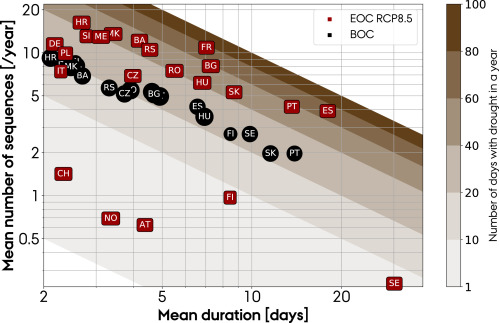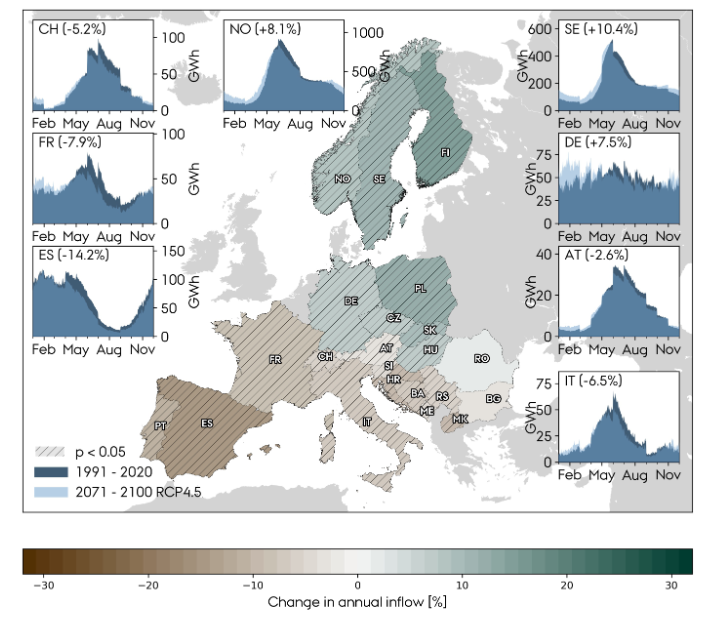
In our recent paper, we investigate the changes in hydro operation due to 1⃣ increasingly wind and solar penetration in the grid (tweets 1-7) and 2⃣ climate change impact on inflow (tweets 8-18). Results from a great MSc project by Ebbe Gøtske @iScience_CP
doi.org/10.1016/j.isci…
doi.org/10.1016/j.isci…
1/ First, a disclaimer. We use PyPSA-Eur-Sec to model the sector-coupled European Energy system. The model assumes perfect foresight for the entire year, which entails an optimal operation of hydro reservoirs. How realistic is that?
2/ To answer that question, we compared the modelled hydro dispatch in 2020 with historically observed data. Modelled daily operation is within observed ranges, but modelled seasonality is a little more extreme than observed ranges. 

3/ This means that the perfect foresight assumption is too optimistic. Constraints in hydro operation due to flood controls or water supply patterns might not be properly captured by the model.
4/ What do we expect in the future? By 2050, the hydropower operation will have to change to balance renewable fluctuation. In Spain, hydro shifts to night and winter, being almost zero at midday. In Norway, hydro compensates for fluctuations of wind generation in the region. 

5/ Is the operation of hydro in 2050 doable?
Historical data for Norway shows that hydro acts as a huge battery charging in June and discharging in winter, so there is room for changing its operation.
Historical data for Norway shows that hydro acts as a huge battery charging in June and discharging in winter, so there is room for changing its operation.

6/ In Spain, historical inflow and dispatch are more correlated. However, since the operation in 2050 requires increasing hydro dispatch in winter (when the inflow is higher), the change also seems possible.
7/ Will hydro need to ramp up/down faster? Modelled data for 2020 show similar/lower ramps than historical values. In the future, we see a more on/off operation of hydro with some ramp peaks higher than historical values (occurring very sporadically) 

8/ What would be the impact of climate change on hydro inflow? To ensure that we can detect a robust signal, we used 5 General Circulation Models (GCM), 2 Regional Climate Model (RCM), 3 emissions scenarios (RCP2.6, 4.5 and 8.5), and 30 years of data for Beginning/End Of Century. 

9/ Runoff from climate models is converted into inflow using #atlite and the location of hydropower plants from JRC.
github.com/energy-modelli…
https://twitter.com/JOSS_TheOJ/status/1408075820170633220
github.com/energy-modelli…

11/ The key question here is the following: Can we observe a clear climate signal on top of GCM-variability, RCM-variability and interannual-variability?
Lots of details in the paper, but we found that:
Interannual variability > GCM-variability > RCM variability
Lots of details in the paper, but we found that:
Interannual variability > GCM-variability > RCM variability
12/ Then we compared two ensembles at the Beginning of the century (BOC) and End of the century (EOC). Each of the ensembles comprises 300 data (10 models x 30 years).
13/ We implemented a t-test to check that, regardless of the variability, the mean annual inflow at the BOC and EOC is different. We found that climate change impacts are statistically significant for 20 out of the 22 countries investigated.
14/ For RCP 8.5, the annual inflow in Spain reduces by 30%. In Norway, it increases by 20%. Seasonality changes. In Norway, less ice forming (due to higher temperatures) increases inflow in winter and decreases in spring. For Spain, inflow gets reduced throughout the whole year. 

15/ Fortunately, it is highly improbable that we end up in the RCP8.5 scenario. For RCP4.5 and RCP2.6. The climate signal is also statistically meaningful for most countries. 

17/ Furthermore, not only the average changes are important but also how climate change will impact droughts. For Mediterranean countries, droughts become more frequent and severe (longer duration). This could stress an energy system that counts on hydro for balancing. 

18/ In 2050, climate change impacts on hydro need to be compensated, e.g. increasing solar capacity in southern countries. These results only include average changes, but significant questions remain open. How do we prepare our energy system to deal with extreme events?
19/ More details in the paper: doi.org/10.1016/j.isci…
Time series for hydro inflow at BOC and EOC for the European countries: zenodo.org/record/5106349…
See also the key resource tables for all the relevant links
Time series for hydro inflow at BOC and EOC for the European countries: zenodo.org/record/5106349…
See also the key resource tables for all the relevant links
• • •
Missing some Tweet in this thread? You can try to
force a refresh





